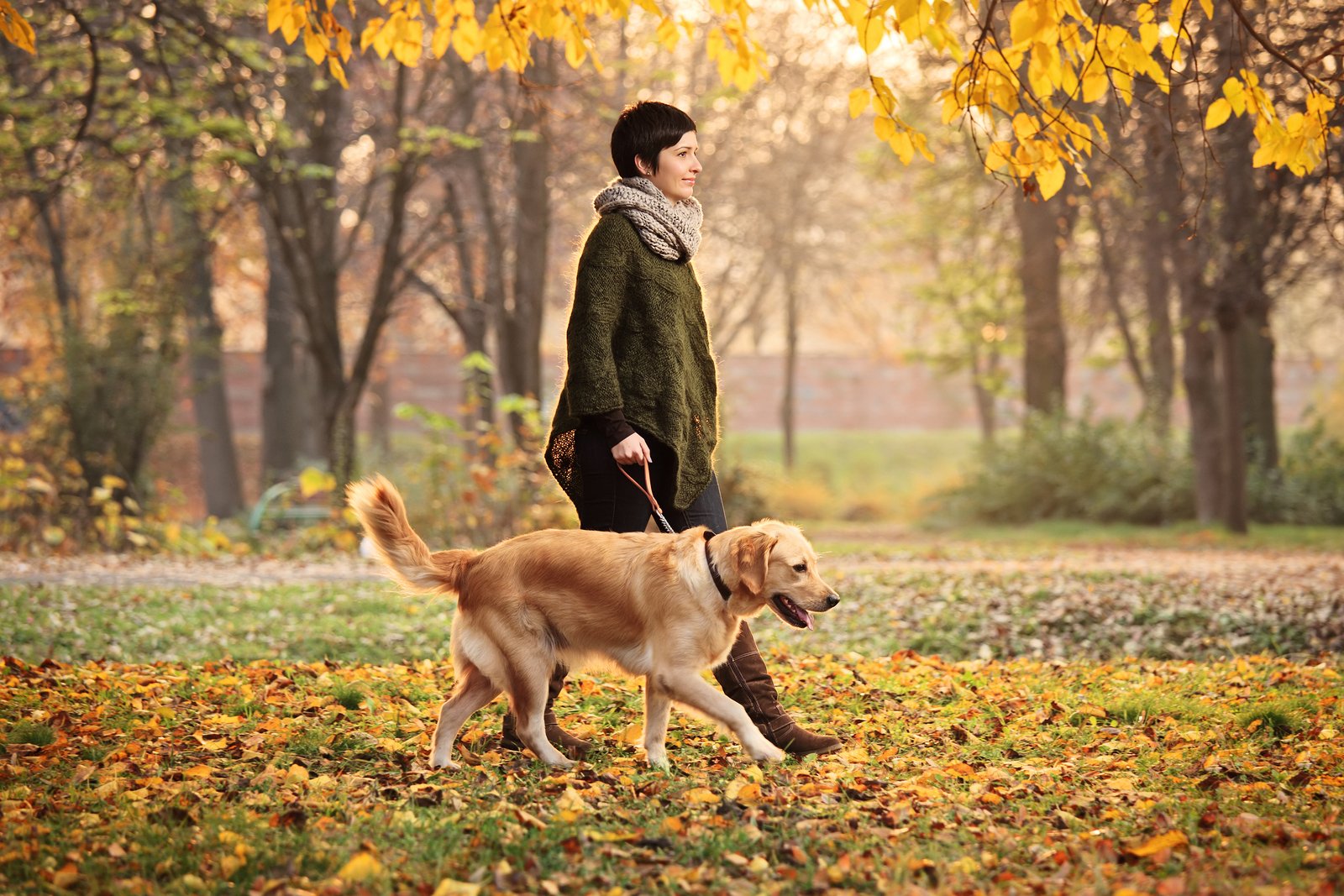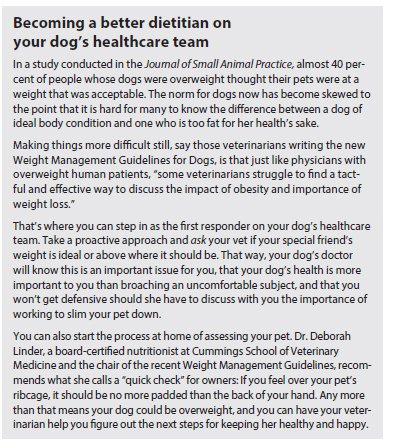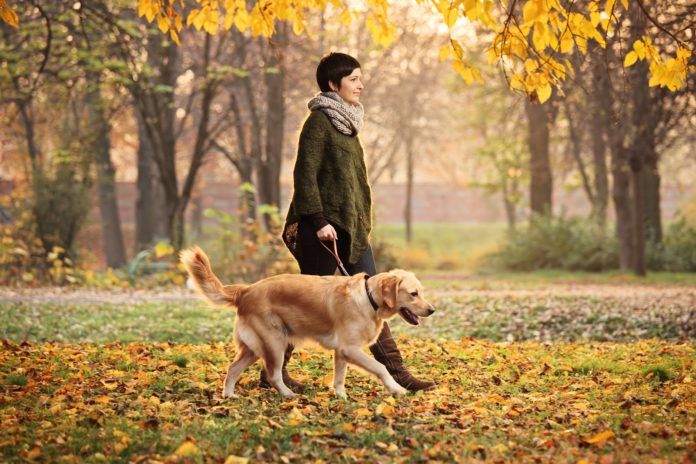In its latest Weight Management Guidelines for Dogs (and Cats), the American Animal Hospital Association has a chart entitled “Issues Impeding/Preventing Weight Loss.” Topping the list in that chart is that the pet “looks hungry” or is “begging.”
BIGSTOCK

The same table lists pet owner “guilt” as an impediment to weight loss. Since up to 59 percent of dogs are overweight (making excess weight the most common nutritional disorder in veterinary practices), there’s a good chance you know the feeling — and the chain of events that leads to your overfeeding.
Your dog looks at you pleadingly, beseechingly, not moving her head or her stance even when you try to ignore her. And you tend to be the one who blinks first — giving in and letting her have the treat, or the table scrap, or whatever food it is she’s after. That doesn’t make you a bad pet “parent.” It makes you a soft touch.
Take heart. You can provide the tough love your overweight dog needs without seeming tough at all. You just need to stop using food as currency for love and redirect all your good feelings for your pet into more healthful channels.
It’s important. Overweight dogs don’t just live two years less, on average, than similar dogs who are at ideal body condition. They pay the price during their lives, too. Excess weight in a dog is associated with skin and respiratory disorders and kidney dysfunction, and it increases the risk for hormone-related disorders like diabetes along with orthopedic diseases such as arthritis and even certain types of cancer. None of these ills are easy to live with. Even those dogs without clinical signs you can see may have increased inflammation inside their body that the extra fat contributes to.
Re-thinking the begging
The veterinarians writing the guidelines say that when an overweight dog begs, it may not be about hunger or unmet nutritional needs or other biological concerns. Much more often, it’s about seeking attention. So you don’t have to worry that a dog who asks for food in a pitying manner actually needs it, as long as you have talked with your veterinarian about meeting her nutritional needs. Even better, the veterinary team points out, “dogs develop stronger bonds with people who walk them than with those who provide food.” In other words, there are activities that can replace treat-giving that have the double benefit of limiting calories and increasing calorie burning through physical activity. And they will get rid of your dog’s sad face, too.
It doesn’t have to be walking. It can be bonding with your pet through other forms of physical activity, including playing fetch in the backyard or signing up your dog for agility classes or other dog “sports” like Rally-O, Flyball, herding or tracking classes, or Musical Freestyle.
The Weight Management Guidelines also offer nine other ways of maintaining, and even strengthening, your bond with your dog that do not involve feeding her more calories than she requires to reach (or remain at) a healthy weight.
1. When your dog begs for food, take a brush and groom her — or forget the grooming and just play with her right in the house. Dogs, like toddlers, are pretty distractable; it’s relatively easy to redirect their attention. So if you don’t feel like going out and exercising with your pet, just calling her away from the food she wants and running a brush through her hair will make her happy. Remember, it’s not the food she’s really after. It’s you. You can also initiate a fun game of fetch right in the house that will engage her attention and make her forget about the treat she thought she was dying for.

2. Distribute a portion of your dog’s diet as treats instead of meals. Treats are important. They are not the whole bond between you and your pet, but they are part of it. One way to make sure she gets some is to take a little of the kibble that would have gone into her bowl and portion it out into a plastic bag from which you dole a morsel at different times of the day.
3. Divide food into more frequent, smaller meals. There’s nothing sacrosanct about two meals a day. Turn it into three, or even four, meals. Just make sure she’s getting the same amount overall that she would have gotten in two feedings. Each of the more frequent meals is going to have to be considerably smaller.
4. Use food as the salary the pet must earn. This isn’t harsh. It just means that it’s okay to teach your dog that food doesn’t just happen. It gets dispensed after she does her “work,” whatever that is — going for a walk, completing a series of tricks, and so on. That puts the emphasis on adding structure and discipline into the day rather than noshing at will when boredom or tedium strikes. This also helps create a “game” for your pet that she will get a charge out of. Dogs need to work for food in the wild and are built to enjoy this activity.
5. Provide environmental enrichment. You can do this with new toys, new games, new walking routes…whatever introduces an element of intrigue into the day and breaks up the routine so your pet can happily anticipate that things will remain interesting.
6. Use food balls and food puzzles. Making a game out of retrieving food that necessitates your dog use her body — and her mind — to get to her meal or snack makes food time last more than a few seconds. Bringing the kibble — or peanut butter or yogurt — to her mouth becomes all the more rewarding.
7. Place food to encourage exercise. Maybe part of a meal is placed in a bowl upstairs, and part of it downstairs. It doesn’t all have to go in the usual spot.
8. Choose low-calorie treats. for example, low-starch vegetables like cucumbers and broccoli. That will allow you to indulge your dog a little more without making her pay the price for it with extra weight.
9. Remove your pet from human feeding areas. One of the places dogs are most likely to be overfed is at the kitchen — or dining room — table. If you make those areas off limits, your dog will not have the opportunity to sit there looking as desperate as possible until you give in and throw her some scraps or let her lick your plate clean when you’re done eating.





